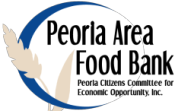We provide assistance with food. Our SNAP Outreach team helps people in Mason, Peoria and Tazewell County with SNAP (food stamps).
Two Ways to Get Help
1. Apply Online
If you prefer, you can apply for SNAP benefits by answering some prequalifying questions by clicking “Apply Online” above. If you are prequalified you will be directed to the Illinois State website to complete your application.
2. Fill out our form and we’ll call you.
Answer a few questions and we will call you Monday through Friday between 9 a.m. and 4 p.m. to assist with your application.
Benefits Referral - SNAP
We can help you look at your financial situation and determine if you can apply for programs like SNAP. You may qualify if your income and other resources are under certain limits. You can have a car, a house, and/or some savings and still be eligible.
If you are undocumented, and have children who are United States citizens, you can apply for SNAP on their behalf.
You’ll need when applying:
-
Identification (for everyone in the household)
-
Social Security Numbers (for everyone in the household)
-
Utility Bills (gas, electric, oil, water, and telephone)
-
Rent Receipt/Agreement or Mortgage Statements and/or Tax Bill
-
Proof of Income (for everyone in the household)
-
Medical Expenses – ONLY if you are 60 and older and/or disabled
-
Child day care expenses
Application and technical assistance is available at the Peoria Area Food Bank (721 W. McBean Street). Or, call 309-213-4843 to speak with Erica Ulrich, SNAP Outreach Specialist.
Other Criteria:
-
Children born in U.S. to undocumented residents may be eligible for SNAP assistance
To learn more about SNAP qualifications, please visit http://www.fns.usda.gov/snap/eligibility.
The U.S. Department of Agriculture prohibits discrimination against its customers, employees and applicants for employment on the basis of race, color, national origin, age, disability, sex, gender identity, religion, reprisal, and where applicable, political beliefs, marital status, familial or parental status, sexual orientation, or all or part of an individual’s income is derived from any public assistance program, or protected genetic information in employment or in any program or activity conducted or funded by the Department. (Not all prohibited bases will apply to all programs and/or employment activities.)
If you wish to file a Civil Right program complaint of discrimination, complete the USDA Program Discrimination Complaint Form, found online at http://www.ascr.usda.gov/complaint_filing_cust.html or at any USDA office, or call (866) 632-9992 to request the form. You may also write a letter containing all of the information requested in the form. Send your completed complaint form or letter to us by mail at U.S. Department of Agriculture, Director, Office of Adjudication, 1400 Independence Avenue, S.W., Washington, D.C., 20250-9410, by fax (202) 690-7442 or email at program.intake@usda.gov.
Individuals who are deaf, hard of hearing or have speech disabilities may contact USDA through the Federal Relay Service at (800) 877-8339; or (800) 845-6136 (Spanish).
For any other information dealing with Supplemental Nutrition Assistance Program (SNAP) issues, persons should either contact the USDA SNAP Hotline Number at (800) 221-5689, which is also in Spanish or call the State Information/Hotline Numbers; found online at http://www.fns.usda.gov/snap/contact_info/hotlines.htm.
USDA is an equal opportunity provider and employer.
The Illinois Department of Human Services is proud to offer online purchasing for more than 1.8 million Supplemental Nutrition Assistance Program (SNAP) customers. To use SNAP benefits online, visit https://shop.aldi.us/, Amazon.com/SNAP or Grocery.Walmart.com and follow the instructions on the screen.
SNAP BENEFITS FOR SENIORS: 7 KEY FOOD ASSISTANCE PROGRAM FACTS
- Few seniors participate in SNAP.
Only 2 out of 5 eligible adults over age 60 are enrolled in SNAP. That means 3 out of 5 seniors who qualify are missing out on benefits. - The average SNAP benefit for seniors is $105/month.
A common myth about SNAP is that it only gives $16 worth of benefits per month. Yes, $16 is the minimummonthly benefit. But 80% of senior SNAP participants receive morethan the minimum. - Many seniors who qualify for the excess medical expense deduction don’t use it.
Currently only 16% of older adults use the medical expense deduction. If you spend more than $35 a month on out-of-pocket medical costs, you might be able to deduct that from your gross income when applying for SNAP. - Many senior SNAP participants experience isolation.
About 80% of older adults who get SNAP benefits live alone. For these seniors, getting an average of $1,272 in SNAP benefits can mean the difference between having food and going hungry. - SNAP helps the local economy.
When SNAP benefits are spent at local stores, it brings money into the community – research foundthat every $1 in additional SNAP benefits generates $1.79 in local economic activity. Plus, additional $1 billion in SNAP benefits would generate 8,900 full-time jobs. - Access to SNAP can reduce health care costs.
When older adults are in debt, they have to make trade-offs that are likely to damage their health. That could mean resorting to skipping meals or reducing medication doses. Participating in SNAP was also linked to lower overall health care expenses and Medicaid/Medicarecosts.
- All the information needed to apply for SNAP can be found in one place
Use the SNAP state directory of resourcesto find each state’s SNAP program. 44 states currently allow people to apply online, so there are also links to the online applications. And in some areas, applications are available in multiple languages.
